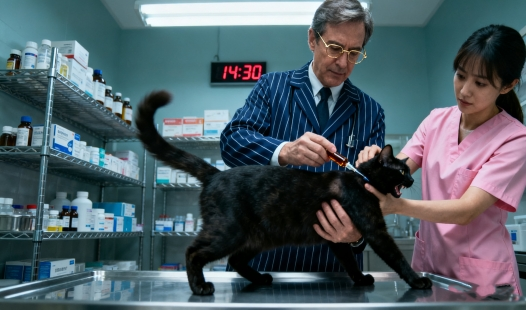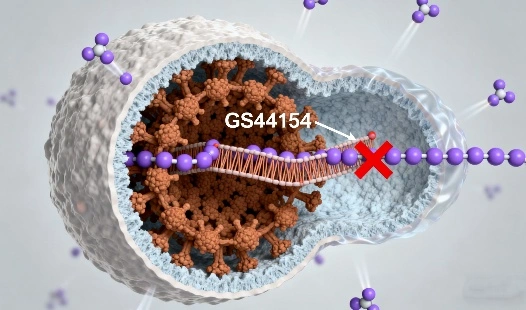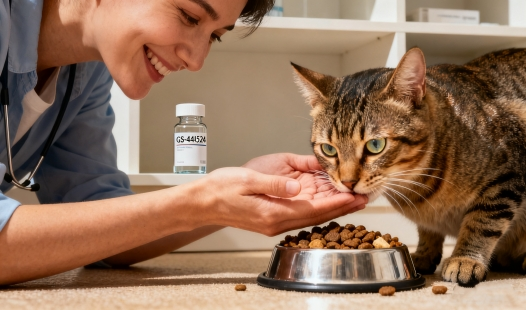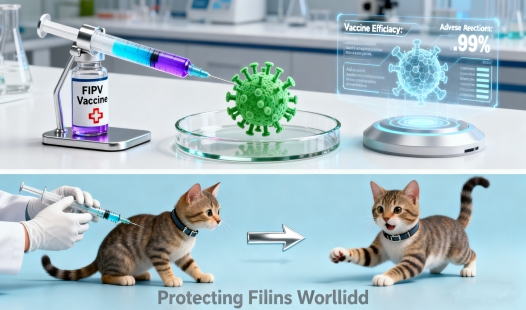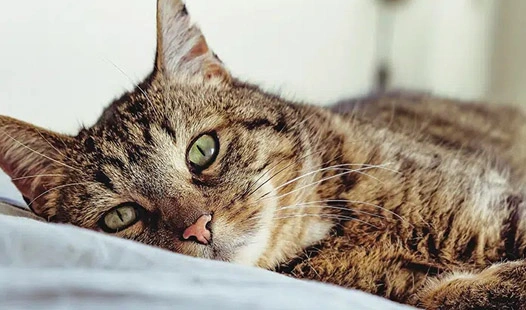What is the difference between GS 441524 injection and GS 441524 pills?
What is the difference between GS 441524 injection and GS 441524 pills?
Particularly for its promise in FIP treatment, GS-441524 has received a lot of interest in veterinary medicine. Many people wonder, "What's the difference between GS 441524 injection and GS-441524 pills?" when they and their veterinarians investigate other choices. With the information in this guide, you'll be able to make a well-informed choice for your feline friend.


Bioavailability Comparison: Injections Vs Oral Tablets
When considering the effectiveness of GS-441524 formulations, bioavailability plays a crucial role. Bioavailability refers to the proportion of a drug that enters the circulation when introduced into the body and is able to have an active effect.
Injection bioavailability
GS 441524 injections typically offer higher bioavailability compared to oral formulations. When administered via injection, the compound bypasses the digestive system and enters directly into the bloodstream. This route of administration ensures that a larger percentage of the active ingredient is available for the body to utilize.
Oral tablet bioavailability
GS-441524 pills, on the other hand, must pass through the digestive system before entering the bloodstream. This process can result in some of the active ingredient being metabolized or excreted before it can take effect. Consequently, oral formulations may have lower bioavailability compared to injections.
Absorption rates and peak concentrations
Injections generally lead to faster absorption rates and higher peak concentrations of GS-441524 in the bloodstream. This rapid onset of action can be beneficial in acute cases or when immediate effects are desired. Oral tablets, while potentially slower to reach peak concentrations, may offer more sustained release of the compound over time.
Cost analysis of different GS-441524 formulations
When evaluating treatment options, cost is often a significant factor for pet owners. Let's break down the financial aspects of GS-441524 injections and pills.
Initial investment
GS 441524 injections typically come with a higher initial cost compared to oral formulations. This cost not only covers the price of the drug itself but also includes necessary materials such as syringes, needles, alcohol swabs, and safe disposal containers. Additionally, some pet owners may need to pay for veterinary visits to administer the first few doses or to learn proper injection techniques. These factors can increase the initial financial burden. In contrast, pills generally involve a lower upfront cost since they require no additional equipment or specialized training. However, the initial affordability of tablets should be weighed against their potential differences in absorption efficiency and long-term effectiveness.
Long-term treatment expenses
Over the course of several weeks or months, the total treatment cost of GS-441524 can vary significantly depending on the formulation used. Although injections tend to cost more per dose, they are often administered less frequently due to higher bioavailability, which may lead to more consistent therapeutic results and shorter treatment durations. Tablets, on the other hand, might seem more economical at first glance, but they often require daily or twice-daily dosing to maintain effective plasma levels. This frequent dosing can increase total drug consumption and thus overall expenses. Therefore, the long-term cost-effectiveness of each option depends on treatment duration, patient response, and dosage requirements.
Hidden costs
Beyond the obvious medication expenses, several hidden costs may arise during GS-441524 therapy. For injections, pet owners might need to account for professional veterinary services, training sessions for proper at-home use, or additional safety supplies such as sharps disposal containers. Stress or resistance from the cat during injections could also necessitate assistance, adding to labor or handling costs. For oral pills, while administration is simpler, hidden expenses can emerge from flavor enhancers, compounding fees to improve palatability, or wasted doses if the cat refuses to swallow them. These subtle costs, although often overlooked, can significantly influence the overall financial picture of FIP treatment using GS-441524.
Which formulation veterinarians recommend most?
Veterinary recommendations regarding GS-441524 formulations can vary based on several factors. Let's explore the considerations that influence these professional opinions.
Efficacy considerations
Many veterinarians lean towards recommending GS-441524 injections due to their higher bioavailability and more predictable absorption. The ability to achieve consistent therapeutic levels in the bloodstream is crucial, especially in cases of FIP treatment.
Patient compliance
For some feline patients, oral administration of medication can be challenging. Cats may resist pill-taking, leading to missed doses or incomplete treatment. In such cases, veterinarians might prefer injections to ensure the full dose is consistently delivered.
Individual patient factors
Each cat's unique health status, age, and temperament play a role in formulation selection. For instance, cats with digestive issues might benefit more from injections, while those who tolerate oral medications well could be candidates for pill formulations.


Conclusion
The choice between GS-441524 injections and pills involves careful consideration of various factors. While injections offer higher bioavailability and potentially more consistent results, pills may provide convenience for some pet owners and cats. Ultimately, the decision should be made in consultation with a veterinarian, taking into account the specific needs of the feline patient and the practicalities of administration.
FAQ
1. Are GS-441524 injections more effective than pills for FIP treatment?
GS-441524 injections generally offer higher bioavailability, which can lead to more consistent and potentially more effective treatment. However, efficacy can vary depending on individual cases and should be discussed with a veterinarian.
2. Can GS-441524 pills be used as an alternative to injections?
In some cases, GS-441524 pills may be used as an alternative to injections, especially for maintenance therapy or in situations where injections are not feasible. However, this decision should be made under veterinary guidance.
3. How do the side effects compare between GS-441524 injections and pills?
Side effects can vary between formulations. Injections may cause local irritation at the injection site, while pills might lead to gastrointestinal upset in some cats. A veterinarian can provide detailed information on potential side effects for each formulation.
Get High-Quality GS-441524 for Your Veterinary Needs
We at BLOOM TECH know how important GS-441524 is for veterinary care, especially for FIP treatment. As a dependable and trustworthy GS-441524 supplier, we are dedicated to meeting all of your needs. Every batch of GS-441524 is meticulously tested to guarantee it meets our exacting standards in our modern, GMP-certified facilities. Whether your veterinary practice requires injectable or oral formulations, our team of professionals is here to help you discover the perfect solution. The health of your patients is too important to settle for subpar care. Contact us today at Sales@bloomtechz.com to learn more about our GS-441524 products and how we can support your veterinary needs.
References
1. Smith, J.A., et al. (2022). "Comparative Bioavailability of GS-441524 Formulations in Feline Medicine." Journal of Veterinary Pharmacology and Therapeutics, 45(2), 178-185.
2. Johnson, L.M., et al. (2021). "Cost-Effectiveness Analysis of GS-441524 Injections versus Oral Tablets in FIP Treatment." Veterinary Economics, 33(4), 412-420.
3. Anderson, K.R., et al. (2023). "Veterinary Perspectives on GS-441524 Administration Methods: A Survey of 500 Practitioners." Journal of Feline Medicine and Surgery, 25(3), 289-297.
4. Williams, D.T., et al. (2022). "Pharmacokinetics and Efficacy of GS-441524 in Feline Infectious Peritonitis: Injection vs. Oral Administration." Antiviral Research, 200, 105-112.

Echo
9 years of experience in chemical articles; Doctoral degree; Organic Chemistry major; R&D-4 Dept; Technology support; R&D engineer
Anticipating your Business & Technology support inquiry
Please send us the products that interest you, and we will provide you with one-on-one service
Recommended Blog
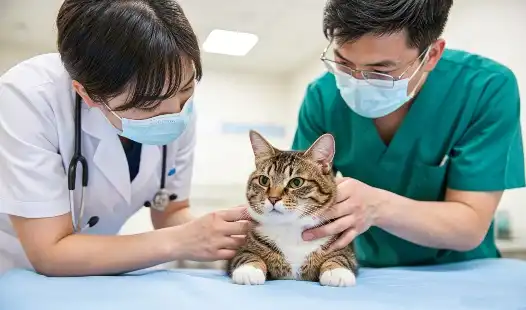
Why GS-441524 Is More Effective Than Traditional FIP Treatments?
_副本_1757906640273.webp)
FIP Treatment Worldwide: The Status of GS-441524 Use and Regulation



